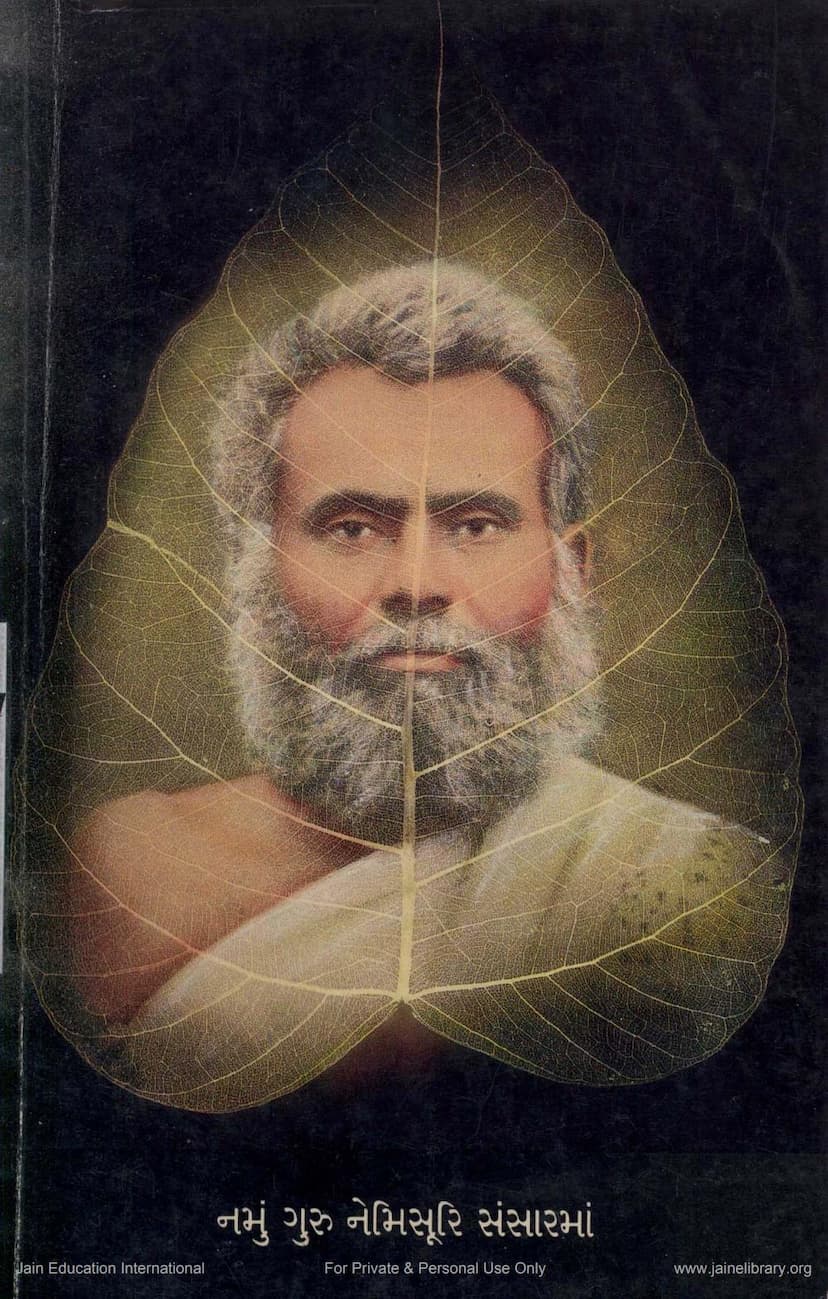Namu Guru Nemisuri Sansarma
Added to library: September 2, 2025

Summary
This text is an excerpt from "Namu Guru Nemisuri Sansarma" (which translates to "Bow to Guru Nemisuri in the World"), a collection of devotional poems and eulogies dedicated to Acharya Shri Nemisuri. The book was authored by Pandit Shilchandrasuri, a disciple of Acharya Shri Vijay Suryoday Surishwarji. The publisher is the Shri Jain Granth Prakashan Samiti, Khambat, and it is available through Shri Vijay Nemisuri Gyanshala in Ahmedabad.
The core of the provided text is the dedication and the introductory verses of the book, which showcase the author's deep reverence for his guru, Acharya Nemisuri.
Here's a breakdown of the key aspects:
- Title: Namu Guru Nemisuri Sansarma (નમુ ગુરુ નેમિસૂરિ સંસારમાં)
- Author: Pandit Shilchandrasuri (પં. શీలચન્દ્રવિજય ગણી)
- Dedication: The book is dedicated to Acharya Shri Nemisuri.
- Inspiration: The work was inspired by the desire and instruction of Acharya Shri Vijay Nandan Surishwarji, who had envisioned composing a eulogy utilizing all types of poetic figures of speech ("Alankars"). He had started this endeavor but left it incomplete. Shilchandrasuri took up this task as a fulfillment of his predecessor's wish.
- Author's Devotion: Shilchandrasuri views his guru, Acharya Nemisuri, as a "Kalpavriksha" (wish-fulfilling tree) and expresses his gratitude for the opportunity to serve and praise him. He acknowledges the possibility of errors in his work and welcomes suggestions from knowledgeable individuals.
- Literary Style: The poems are composed in the "Arya" meter and are characterized by devotional fervor.
- Content: The excerpt then proceeds to list and present various Sanskrit poetic figures of speech (Alankars), each accompanied by a verse eulogizing Acharya Nemisuri. These figures of speech are used to describe his virtues, qualities, and achievements. Examples of Alankars used include:
- Upama (Simile)
- Ananvaya (Comparison with oneself)
- Upameyo-pama (Comparison where the object of comparison is also used for comparison)
- Pratipa (Inverted simile, where the object of comparison is presented as superior)
- Rupaka (Metaphor)
- Parinam (Metaphorical transformation)
- Ullekha (Listing different attributes)
- Smriti (Reminiscence)
- Bhramti (Delusion or confusion)
- Sandeh (Doubt)
- Apahnuti (Concealment)
- Hetvapanuti (Concealment of the cause)
- Paryastapanuti (Reversal of concealment)
- Bhramtapahnuti (Concealment due to delusion)
- Chhekapahnuti (Clever concealment)
- Kaitvapanuti (Deceptive concealment)
- Utpreksha (Poetic fancy or imagination)
- Rupakatisshayokti (Metaphorical exaggeration)
- Sapanhavatisshayokti (Exaggeration with concealment)
- Bhedakatisshayokti (Exaggeration highlighting a difference)
- Sambandhatisshayokti (Exaggeration of connection)
- Asambandhatisshayokti (Exaggeration of non-connection)
- Akramatisshayokti (Exaggeration of illogical sequence)
- Chapala-tisshayokti (Exaggeration of fickleness)
- Atyantatisshayokti (Extreme exaggeration)
- Tulyayogita (Similarity of attributes)
- Deepak (Lamp, illuminating diverse objects)
- Avriti-deepak (Repetitive lamp)
- Prativastupama (Analogy of individual things)
- Drishtanta (Example or illustration)
- Nidarshana (Illustration showing resemblance)
- Vyatirek (Contrast)
- Sahokti (Accompaniment)
- Vinokti (Irony)
- Samasokti (Figurative statement implying something else)
- Parikar (Supplement)
- Parikarankur (Bud of supplement)
- Shlesh (Puns or double meanings)
- Aprastut-prashansa (Praise of something not directly mentioned)
- Prastutankur (Sprout of the present topic)
- Paryayokta (Circumlocution)
- Vyajastuti (Praise that implies criticism)
- Vyaj-ninda (Criticism that implies praise)
- Akshep (Objection)
- Virodhabhas (Apparent contradiction)
- Vibhavana (Cause without an apparent reason)
- Visheshokti (Special statement)
- Asambhav (Impossibility)
- Asangati (Incongruity)
- Vishama (Inequality)
- Sama (Equality)
- Vichitra (Wonderful)
- Adhikam (More)
- Alpam (Less)
- Anyonyam (Mutual)
- Vishesh (Special)
- Vygghata (Obstacle)
- Karanmala (Garland of causes)
- Ekavali (Continuous description)
- Maladeepak (Lamp on a string)
- Sar (Essence)
- Yathasankhya (According to number)
- Paryay (Alternative)
- Parivrutti (Exchange)
- Parisavya (Surrounding)
- Vikalpa (Alternative)
- Samuchchaya (Collection)
- Karakdeepak (Deepak with an agent)
- Samadhi (Concentration)
- Pratyaneek (Adversary)
- Arthapatti (Presumption)
- Kavyalinga (Poetic reason)
- Arthantranyas (General statement supported by specific example)
- Vikasar (Blooming)
- Praudokti (Proud statement)
- Sambhavana (Possibility)
- Mithyadhyavasiti (False attribution)
- Lalita (Graceful)
- Praharshan (Joy)
- Visadan (Sadness)
- Ullasa (Exhilaration)
- Avagya (Disrespect)
- Anugna (Permission)
- Lesha (Little)
- Mudra (Seal)
- Ralavali (Collection of gems)
- Tadguna (Its quality)
- Purvarup (Previous form)
- Atadguna (Not its quality)
- Anuguna (In accordance with quality)
- Milita (Mixed)
- Samanya (Common)
- Unmilita (Opened)
- Visheshak (Distinguishing)
- Uttar (Answer)
- Sukshma (Subtle)
- Pihita (Covered)
- Vyajokti (Obscure speech)
- Gudhokti (Hidden speech)
- Vivrutokti (Open speech)
- Yukti (Logic)
- Lokokti (Proverb)
- Chhekokti (Witty statement)
- Vakokti (Crooked speech)
- Swabhavaokti (Natural statement)
- Bhavika (Prophetic)
- Udatta (Noble)
- Atyukti (Exaggeration)
- Nirukti (Definition)
- Pratishedh (Prohibition)
- Vidhi (Law)
- Hetu (Reason)
The text is a testament to the rich tradition of devotional literature in Jainism, where poetic artistry is used to glorify spiritual leaders and their teachings. The inclusion of a vast array of Alankars demonstrates the author's mastery of Sanskrit poetics and his dedication to honoring his guru through elaborate praise. The book aims to inspire devotion and reflection on the virtues of Acharya Nemisuri.